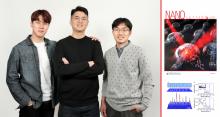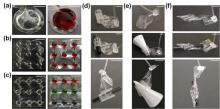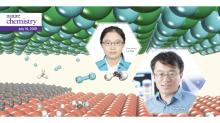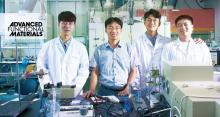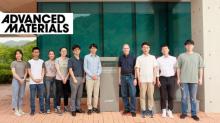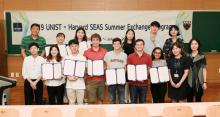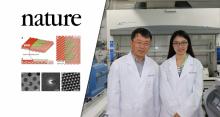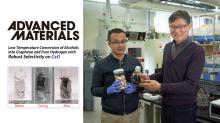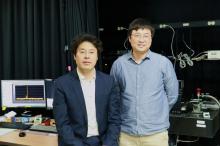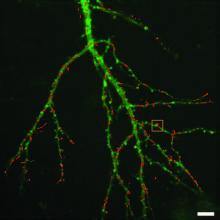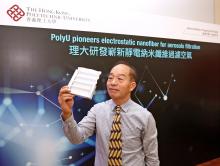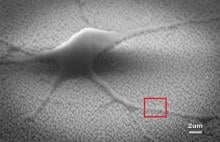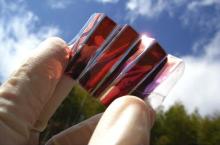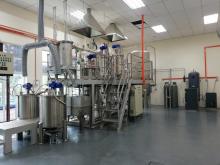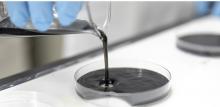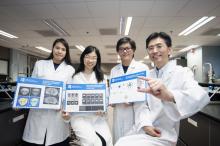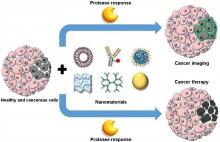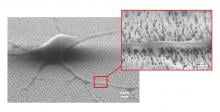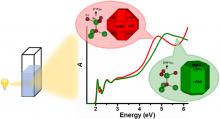Materials Science and Engineering Nanomaterials
News
10 Jun 2020
Metal-organic frameworks (MOFs) are sponge-like organic-inorganic hybrid materials and have a variety of uses due to their ultra-high “porosity,” or the ratio of pores or air pockets to the solid material. Through a technique called “post-synthetic modification,” Professor Jinhee Park and her research team were able to enhance and modify the function of these materials for specific purposes.
10 Mar 2020
A recent study, affiliated with South Korea's Ulsan National Institute of Science and Technology (UNIST) has introduced a novel technology, which allows carbon nanotubes (CNTs) to be easily observed under room temperature.
21 Oct 2019
DGIST Professor Sohee Kim’s Team developed a technology to produce 3D soft and flexible devices by blowing balloons made of polymeric thin films. Can be made in various 3D shapes... Expected to have diverse medical and biomedical applications.
04 Sep 2019
A recent study, affiliated with South Korea's Ulsan National Institute of Science and Technology (UNIST) has demonstrated fluorine speeds up two-dimensional materials growth.
04 Sep 2019
The academic journal Lab on a Chip has selected UNIST Professor Joo Hun Kang as an Emerging Investigator in 2019.
02 Sep 2019
A recent study, affiliated with South Korea's Ulsan National Institute of Science and Technology (UNIST) has succeeded in detecting a single ion using the approach through the interiors of the CNTs.
29 Aug 2019
A summer exchange program, operated by South Korea's Ulsan National Institute of Science and Technology (UNIST) and Harvard John A. Paulson School of Engineering and Applied Sciences (SEAS), ended with great success.
27 Aug 2019
A recent study, affiliated with South Korea's Ulsan National Institute of Science and Technology (UNIST) gives explanation for how to enlarge 2D materials as single crystals.
27 Aug 2019
A recent study, affiliated with South Korea's Ulsan National Institute of Science and Technology (UNIST) has unveiled a new way to turn discarded eggshells into hydrogen, an innovative and alternative energy for the future.
26 Aug 2019
A recent study, affiliated with South Korea's Ulsan National Institute of Science and Technology (UNIST) has introduced a pressure-free approach for creating synthetic graphite with well-oriented crystallites.
20 May 2019
Researchers in Korea and colleauges have developed a polariton nano-laser operating at room temperature.
16 Apr 2019
Luminescing nanosized crystals are showing promise for peering deeply into body tissues, but first they need to be made safe.
27 Mar 2019
The Department of Mechanical Engineering of The Hong Kong Polytechnic University (PolyU) (PolyU) has recently developed an electrostatically charged nanofiber filter with multiple separator layers, which can capture pollutant particles that are below 100 nm in diameter (covering the most common airborne nano-particles and viruses).
26 Mar 2019
A transparent, flexible smartphone sensor also measures skin temperature and tactile pressure, which could combat fingerprint forgery and make mobile devices even more compact.
25 Mar 2019
Molecular nanowires can be used for many applications, from LED lights to medical devices.
15 Mar 2019
Developing materials similar to graphene remains a challenge, but chemists are making progress, moving closer to smaller, faster electronics and photonics.
01 Mar 2019
An award-winning device employs nanotechnology to safely grow neural stem cells for replacement therapy research.
24 Jan 2019
Nanocellulose offers renewable, biodegradable, strong and lightweight components for electronic products.
13 Dec 2018
The present invention provides a method to produce black iron oxide nanoparticle slurry having a magnetite structure and homogenously disperse. It can be used as formed or mix with other medium.
10 Dec 2018
Flexible skin for soft robots, embedded with electrical nanowires, combines conductivity with sensitivity within the same material.
27 Nov 2018
An inexpensive hydrogel-based material efficiently captures moisture even from low-humidity air and then releases it on demand.
30 Oct 2018
HKBU researchers have discovered a new nanomaterial which could enable the early detection and diagnosis of Alzheimer’s disease.
29 Oct 2018
Nanomaterials that respond to cancer-specific stimuli show potential in the targeted delivery of treatments and imaging compounds, but many challenges remain.
19 Jun 2018
HKBU scholars invent award-winning medical device for safe growth of neural stem cells using nanotechnology.

20 Feb 2018
Nanomaterial coating enables efficient delivery of CRISPR-Cas9 machinery into the cell.
01 Sep 2017
Investigation of paper-based electronics continues to advance, showing exciting signs of progress.
06 Jul 2017
Korean researcher Sung Jun Lim suggests easy analysis method to identify the structure of semiconductor nanoparticles in solution only by measuring absorption spectrum. It is expected to present a new direction for the studies of the structure and the properties of nanoparticles.
09 Jun 2017
A research team, led by South Korea's Ulsan National Institute of Science and Technology (UNIST) has engineered a new type of carbon nanomaterials, capable of changing shapes and colors depending on the type of solvents used. Their findings appeared in the prestigious journal, Advanced Materials.
Events
Sorry, nothing coming up for this discipline
Researchers
Sorry, nothing coming up for this discipline
Giants in history
Sorry, nothing coming up for this discipline



